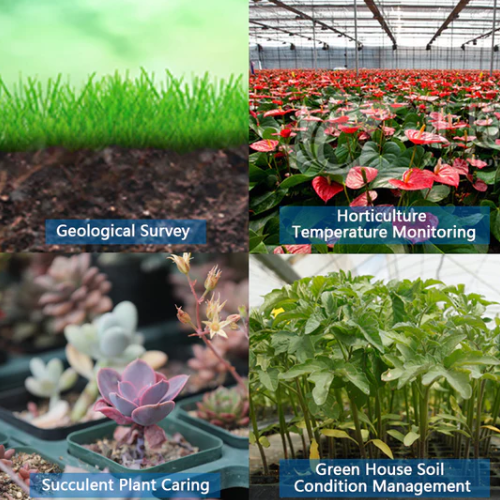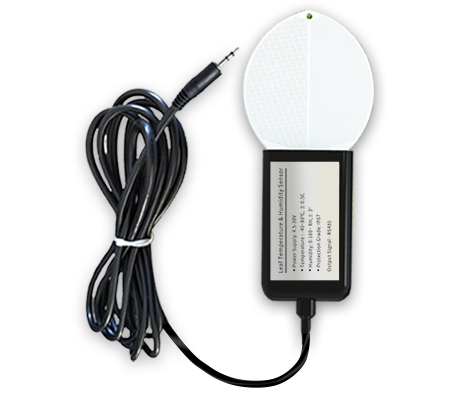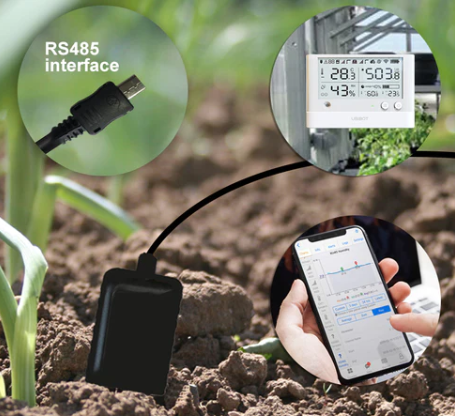The Best Soil Sensors to Optimize Your Yields
Maximizing Growth:
Harnessing the Power of Soil Sensors and
Data Loggers in Greenhouse Agriculture
Harnessing the Power of Soil Sensors and
Data Loggers in Greenhouse Agriculture
Greenhouse agriculture has evolved significantly with the integration of advanced technologies. Soil sensors and data loggers have emerged as indispensable tools in modern greenhouse management. Greenhouse managers must closely monitor soil conditions to optimizing plant growth.
In this comprehensive blog post, we will delve into the role of soil sensors and wireless data loggers in greenhouse agriculture. This blog will focus on soil moisture sensors, soil EC sensors (EC), soil PH probes, soil NPK sensors (nitrogen, phosphorus, and potassium), and leaf moisture sensors. We will also explore the benefits of integrating these soil sensors into modern data loggers and cloud-based monitoring software.
Understanding the functionalities and applications of these technologies is crucial for managers seeking to optimize their crop yields and ensure sustainable agricultural practices.
Soil Moisture Sensors for Precision Agriculture
Soil moisture and temperature sensors serve as the backbone of precision agriculture within greenhouses. These sensors provide real-time data on the moisture content and temperature of the soil, enabling growers to fine-tune irrigation practices and create an environment conducive to optimal plant growth.
Moisture Management:
Overwatering and underwatering can both have detrimental effects on plant health and yield. By receiving accurate data on soil moisture content, growers can implement precise irrigation strategies, preventing water wastage and optimizing water use efficiency.
Temperature Management:
Soil moisture sensors typically also measure temperature. Soil temperature plays a pivotal role in various physiological processes within plants. Accurate temperature data allows growers to monitor soil temperature fluctuations and make informed decisions regarding planting times, germination conditions, and overall crop health. This assists in preventing stress-related issues that may arise from extreme temperature variations, ensuring that plants are in an environment conducive to their growth.

Soil EC Sensors (Electrical Conductivity) for Nutrient Monitoring:
Soil EC sensors are vital tools for assessing the nutrient levels in the soil. These sensors measure the ability of the soil solution to conduct an electrical current, which correlates with the concentration of essential nutrients. By using soil EC sensors, greenhouse operators can gauge the soil’s overall fertility and adjust nutrient supplementation accordingly.
Nutrient Management:
Soil EC sensors play a crucial role in optimizing nutrient delivery to plants. Maintaining an appropriate EC level ensures that the right balance of essential elements is available for uptake. This precision in nutrient management promotes healthy plant growth and prevents the risk of nutrient deficiencies or toxicities. Furthermore, soil EC sensors aid in identifying issues related to imbalances in nutrient levels, allowing for targeted adjustments in fertilization practices.
Soil PH Probes for Soil Acidity/ Alkalinity Management:
Soil PH is a critical factor influencing nutrient availability to plants. PH soil probes measure the acidity or alkalinity of the soil, providing vital information for growers to adjust PH levels and create an environment conducive to nutrient absorption.
Different crops thrive in specific PH ranges. Soil PH probes help greenhouse operators tailor the soil conditions to meet the preferences of the cultivated plants. For example, some plants prefer slightly acidic soils, while others thrive in more alkaline conditions. Maintaining the appropriate pH level ensures optimal nutrient availability and absorption and prevents nutrient lockout. This occurs when certain nutrients become less available to plants due to extreme pH levels.
Regardless of you application, UbiBot’s soil PH probes will provide superior performance for you business.
Soil NPK Sensors for Comprehensive Nutrient Monitoring
Soil NPK sensors are specialized sensors which measure nitrogen (N), phosphorus (P), and potassium (K) in the soil. These are the three primary nutrients essential for plant growth. Monitoring these nutrients is crucial for preventing deficiencies or excesses that can negatively affect crop development.
Nitrogen (N):
Nitrogen is a key component of amino acids, proteins, and chlorophyll. Adjusting nitrogen levels based on real-time data enhances photosynthesis, promotes leafy growth, and contributes to overall plant health. Management or nitrogen levels is particularly vital as it directly impacts plant development and has implications for crop yield and quality.
Phosphorus (P):
Phosphorus is essential for energy transfer and storage within plants. Management of phosphorus is critical for maximizing the reproductive potential of plants, influencing both flower and fruit development. Precise monitoring prevents the risk of phosphorus deficiencies, particularly in crops with high phosphorus requirements.
Potassium (K):
Soil NPK sensors also monitor potassium levels, a vital nutrient for enzyme activation, water regulation, and overall plant resilience. By ensuring an appropriate balance of potassium, growers can enhance drought tolerance, disease resistance, and the quality of harvested produce. Potassium management is integral to maintaining overall plant health and resilience to environmental stresses. This in turn, contributes to the sustainability and productivity of greenhouse crops.
Leaf Moisture Sensors: Advancing Precision Agriculture
The use of leaf moisture sensors stands out as a game-changer for optimizing plant health within greenhouses. These specialized sensors provide direct insights into plant physiology by measuring moisture content and temperature in the simulated leaves. Combined with the soil moisture sensors mentioned above, leaf moisture sensors are a valuable tool for greenhouse managers. The benefits of including leaf moisture sensors in your operation are:
- Comprehensive Monitoring: Leaf moisture sensors employ advanced technologies such as capacitance or impedance to provide insights into moisture levels within plant leaves. Integrated temperature probes or thermocouples simultaneously offer crucial data on leaf temperature, influencing key physiological processes like photosynthesis and transpiration.
- Real-Time Insights: The real-time nature of leaf sensors enables continuous monitoring, allowing growers to observe immediate responses to environmental changes. This facilitates prompt adjustments in cultivation practices, optimizing irrigation schedules based on direct assessments of leaf moisture content and preventing both overwatering and underwatering scenarios.
- Wireless Connectivity: Some leaf moisture sensors feature wireless communication capabilities, enabling seamless data transmission to central monitoring systems or cloud platforms. This facilitates remote access to information, supporting timely decision-making and proactive interventions, contributing to optimized irrigation strategies and overall crop health.

UbiBot's Leaf Moisture and Temperature Sensor is Ideal for Optimizing your Greenhouse Operations
- Early Stress Detection: Leaf moisture sensors play a pivotal role in early stress detection, providing a proactive approach to managing potential issues before they escalate. This preventive capability contributes to the overall health and resilience of greenhouse crops.
As agriculture embraces technological advancements, the integration of leaf moisture and temperature sensors underscores a commitment to precision, efficiency, and sustainability. These sensors empower growers with actionable insights, fostering informed decision-making and contributing to a more resilient and productive future for greenhouse agriculture.
Enhancing Precision Agriculture with Soil Sensors, UbiBot Wireless Data Loggers and Cloud App Integration:
Soil sensors such as the soil moisture sensors, EC sensors, PH soil probes, NPK sensors and leaf moisture sensors play pivotal roles in greenhouse agriculture. Their effectiveness can be further amplified through seamless integration with advanced data logging and cloud-based monitoring systems.
UbiBot’s industry leading data loggers combined with UbiBot’s cloud-based app, provides growers with a comprehensive platform to collect, analyze, and visualize real-time and historical data from a multitude of sensors. The benefits of these systems are discussed below.
1. Data Synthesis and Analysis: UbiBot data loggers act as central hubs, aggregating data from various soil sensors, including moisture, temperature, EC, pH, and NPK sensors. The UbiBot app stores and processes this data, offering growers a holistic view of their greenhouse environment. By combining information from multiple sensors, farmers gain an in-depth understanding of the interplay between different factors influencing plant health and growth.
2. Real-Time Monitoring: Growers can access up-to-the-minute information about their greenhouse. Timely information facilitates prompt decision-making and intervention when necessary. This level of immediacy is particularly valuable in addressing sudden changes in conditions, such as unexpected temperature spikes or drops.

UbiBot Soil Moisture Probes shown with a WS1-Pro data Logger.
The UbiBot cloud allows customers to access all information remotely.
spacer
3. Customized Alerts and Notifications: UbiBot’s app allows users to set customized thresholds and receive alerts when specified conditions are met or deviate from the desired range. For example, if soil moisture levels drop below a predefined limit, the system will notify staff to adjust irrigation. This proactive approach to monitoring empowers growers to address issues promptly, reducing the risk of crop stress and yield losses.
4. Historical Data for Informed Decision-Making: The UbiBot app provides a historical database of sensor readings, allowing growers to analyze trends over time. This data-driven approach facilitates informed decision-making, as farmers can identify patterns, assess the impact of interventions, and optimize their practices. Historical analysis is invaluable for refining strategies and maximizing long-term productivity.
5. Remote Accessibility and Management: UbiBot’s cloud-based app enables remote accessibility, allowing growers to monitor and manage their greenhouse or nursery operations from anywhere with an internet connection. This flexibility is particularly advantageous for farmers overseeing multiple locations or those who require off-site monitoring capabilities. The ability to access real-time data remotely enhances operational efficiency and reduces the need for constant on-site presence.
6. Integration with IoT Ecosystem: UbiBot data loggers are part of a broader Internet-of-Things (IoT) ecosystem, creating integration possibilities with other smart devices and technologies. Such interconnectedness creates a synergistic environment where data from soil sensors seamlessly integrates with other IoT devices. This integration enhances the overall efficiency and intelligence of the greenhouse system.
Conclusion
Integrating UbiBot’s wifi data loggers and the console with soil sensors will improves the precision and efficiency of your greenhouse. UbiBot’s soil moisture sensor, soil EC sensor, soil PH probe, soil NPK probe, and leaf humidity sensor are ideal tools to help you optimize your yields.
Combining these sensors and a UbiBot data logger with the UbiBot console provides managers with access to real-time data on all the key indicators of plant health. The information coupled with advanced analytics and remote accessibility, empowers growers to make informed decisions and implement timely interventions. This in turn optimizes agricultural practices for maximum yield and sustainability.
As technology evolves, the collaboration between smart soil sensors and data logging platforms exemplifies the potential for innovation in modern agriculture. This paves the way for a more connected, intelligent, and resilient future in greenhouse farming.
How can UbiBot Canada Help your Greenhouse?
UbiBot Canada stocks the soil sensors and data loggers discussed in this blog post. Furthermore, we stock the following data loggers which are ideal for your greenhouse:
- WS1-Pro wireless data logger:
- This mid-range wifi data logger is compatible with the soil temperature and moisture probe.
- GS1 environmental data logger:
- UbiBot’s premier wifi data logger is a powerful device which meets all your needs for managing a greenhouse. The GS1 wireless data logger is compatible (model dependant) with all the soil sensors and the leaf sensor discussed above:
In addition to the soil sensors discussed above as well as many other probes and sensors that are ideal for your greenhouse. To learn more about the importance of data loggers, smart plugs, CO2 sensors and humidity sensors please read this blog post.
Contact us today to learn more about how UbiBot soil probes, leaf sensors and data loggers can help your greenhouse.